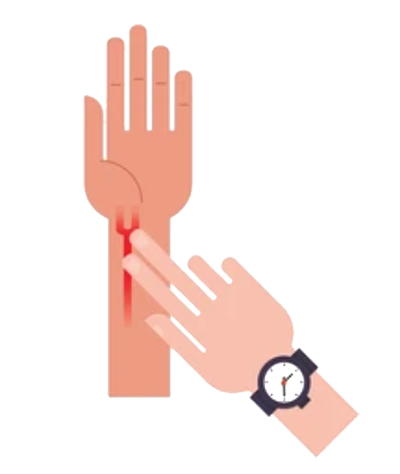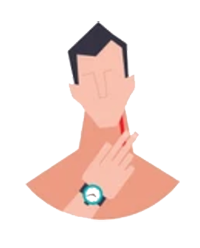Take your workout to the next level by tracking your heart rate!
The key to a great workout is to train to match your goals. And this requires exercising at the right intensity and getting into the right training zone.
For example, some workouts are short and intense, which builds speed and power. Other workouts are super long and light in intensity, which develops cardiovascular endurance. Each way of exercising achieves different outcomes.

Heart Rate Zones: A Full Guide
Find out about the 5 heart rate zones, the particular benefits of each zone, and when to work out in each training zone.
Heart-rate training involves exercising in personalized training zones that are determined using your heart rate to help you know how intensely you are exercising during your workout. Heart rate (HR) is one of the best indicators of exercise intensity and effort.
| Zone | Heart Rate | Feels | Example |
|---|---|---|---|
| Zone 1 (Recovery) | 50–65% MHR | Very Light | Warm-up |
| Zone 2 (Aerobic) | 65–75% MHR | Light | LISS/ LSD |
| Zone 3 (Lactate Threshold) | 75–85% MHR | Moderate | Tempo run |
| Zone 4 (Anaerobic) | 85–95% MHR | Hard | HIIT |
| Zone 5 (Maximal) | 95–100% MHR | Very Hard | SIT/ Tabata |
Heart rate or percentage of your maximum heart rate (MHR) is used as a guide for intensity.
There are two of main methods of estimating your heart rate training zone.
Method 1
Age-Adjusted Method
This is the most common method for calculating heart rate training zone (the range in which your heart rate should remain while exercising).
The age-adjusted method is very simple. However, this simplicity is also one of the reasons this method has quite a few critics.
To calculate your heart rate training zone, perform the following calculation:
1 Determine Maximum Heart Rate
220 – age in years
In other words, subtract your age in years from 220.
2 Heart Rate Training Zone for Exercise
MHR x % target intensity
In other words, multiply your maximum heart rate (step 1) by the target exercise intensity (as a percentage of maximum heart rate).
Example
A 35-year-old person wants to train in zone 2, which is 65% – 75% of MHR
Step 1
220 – age in years
That would be: 220-35 = 185
So maximum heart rate = 185 bpm
Step 2
MHR x target intensity
For 65% MHR, that would be: 185 x 65% = 120 bpm
For 75% MHR, that would be: 185 x 75% = 139 bpm
So, according to this method, exercising in zone 2 would require that heart rate remains between 120 bpm and 139 bpm.
Critics of the age-adjusted method believe that this formula does not reflect the needs of individual exercisers or take into account current fitness levels.
Method 2
KARVONAN METHOD
This more personalized method for calculating your heart rate training zone is called Karvonan method or the Heart Rate Reserve method.
The Karvonen method can be summed up in one mammoth mathematical formula:
Exercise HR = [% target exercise intensity x (HR max – HR rest)] + HR rest
To use this calculation, you need to know your resting heart rate. Obtain this figure by taking your heart rate when you are relaxed, well rested and caffeine-free. So your best bet is to do it first thing in the morning, just after waking up (see how to take your heart rate below).
Here’s how to work through the equation step-by-step.
1 Determine Maximum Heart Rate
220 – age in years
In other words, subtract your age in years from 220.
2 Take Your Resting Heart Rate
To obtain your resting heart rate take your pulse for 60 seconds when you are relaxed, well rested and caffeine-free.
So your best bet is to take your heart rate first thing in the morning, just after waking up.
3 Calculate Your Heart-Rate Reserve
MHR – Resting HR
(Number from Step 1 – Number from Step 2)
In other words, subtract your resting heart rate from your maximum heart rate.
4 Determine Heart Rate Training Zone
(HR Reserve x target intensity) + HR Rest
(Number from Step 3 x % intensity at which you want to exercise) + Number from Step 2
In other words, first multiply your heart-rate reserve (step 3) by target exercise intensity (as a percentage of maximum heart rate), and afterwards add back your resting heart rate (step 2).
Simply repeat this final step, to determine the different heart rate zones. Plugging in the different % target intensity to find the different zones.
It seems repetitive or counterintuitive, but you do need to subtract your resting heart rate at the previous step, and then add it back in this step. Just be sure to follow the steps in order.
Example
A 35-year-old person with a resting heart rate of 60 bpm wants to exercise in zone 2, which is 65 – 75% of MHR.
Step 1
220 – age in years
That would be: 220 – 35 = 185
So, maximum heart rate = 185 bpm
Step 2
Resting heart rate = 60 bpm
Step 3
MHR – Resting HR
That would be: 185 – 60 = 125
So, heart rate reserve = 125 bpm
Step 4
(HR Reserve x % target intensity) + HR Rest
For 65% MHR, that would be: 125 x 65% = 81
Then, add HR Rest: 81 + 60 = 141 bpm
For 75% MHR, that would be: 125 x 75% = 94
Then, add HR Rest: 94 + 60 = 154 bpm
So, exercising in zone 2, would require that heart rate remains between 141 bpm and 154 bpm.
You can repeat this for other exercise intensities (i.e. zones), as shown in the table above.
As you can see, this method results in a higher heart rate than the basic age-adjusted method calculation for the same exerciser.
What Next?
Getting Started
The formulae used to estimate maximum heart rate are based on population statistics and do not take factors such as your unique physiology, genetics and certain medications into consideration, which can impact MHR and result in different MHR results for people of the same age.
Therefore, once you’ve estimated your heart rate zones, fine-tune them using the Rating of Perceived Exertion (RPE) scale to make your heart rate training more individualized and accurate, and get the best possible results.
If you’re doing different activities, also tailor the heart rate zones for each sport (e.g. running, swimming), because every activity will feel different and place different demands on the body.
The only way to truly determine your own specific maximum heart rate is to do a maximal heart rate test. The gold standard for determining maximum heart rate would actually involve a treadmill stress test in a lab with a cardiologist.
Consider the following when doing maximal heart rate testing:
- MHR testing should only be attempted if you’re very fit and healthy.
- You should be well rested before and energised enough to push yourself to reach your maximum-effort threshold.
- Warm-up before completing the test.
- Complete the test using the specific activity you plan on doing, e.g. running, cycling, etc.

Fitness Tests: Full Guide
Test your fitness with this comprehensive guide. Find out how to do the 6 key fitness tests.
Working out using heart rate zones can help you make your workout routine more balanced and allows you to achieve specific fitness goals.
If you are a beginner or returning to exercise, start with lower intensity exercise and gradually build up difficulty as you become more fit.
Speak to health care professional, if you have symptoms or a pre-existing medical condition, to get advice on the best heart rate zone for you.
How to Take Your Heart Rate

Taking pulse from your wrist:
- Turn your hand so that your palm is facing up.
- Using the tips of your index and middle fingers of your other hand, gently feel for a groove on your forearm, just below the fold of your wrist and the base of your thumb.
- Press lightly over the radial artery to take your pulse.

Taking pulse from your neck:
- Place your index & middle fingers on the carotid artery, which is on your neck just below the angle of your jaw and to the side of your windpipe.
- Press very lightly over the carotid artery, just enough to feel each beat. Do not press too hard as this will obstruct blood flow.
- Do NOT feel for both carotid artery pulses at the same time, as this may cause you to faint, or feel lightheaded or dizzy.
Take pulse for a full 60 seconds to determine your heart rate, or take for 30 seconds and multiply by 2.


